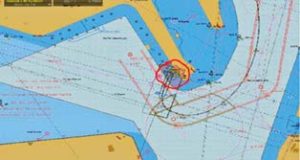The Charity
Aviation
Maritime
Touching bottom while berthing causes rudder damage

Initial Report
Initial report
A loaded tanker (14m draft) entered harbour and approached its berth. The bridge and mooring stations were fully crewed. The pilot embarked and a comprehensive master-pilot exchange took place. All equipment was reported in good condition and working. Two tugs were made fast – one at the bow and one at the stern.
As it passed the mooring dolphin, the vessel turned short round to port, assisted by the tugs. About 5 minutes later the officer at the stern alerted the bridge that the vessel was drifting towards the end of the breakwater. The current was running in an easterly direction during the turn to port, which caused the drift, although the pilot believed that it was running in a westerly direction. The pilot gave several engine orders from dead slow to full ahead to increase the distance from the breakwater, but a noise was heard on the port quarter. Following checks within the engine room to ensure the hull was not breached, the vessel berthed port side alongside at the oil terminal.

An investigation revealed that there were no fatigue issues nor any substance abuse. All equipment was in-class and properly maintained. The passage plan berth to berth was very comprehensive and under-keel clearance (UKC) calculations were prepared and shown to the pilot at the master-pilot exchange. All navigational equipment relevant to this passage plan was being used and accurate. The bridge team members were adequately trained for making proper use of all navigational aids, and for being aware at all times of the vessel’s position. The master-pilot exchanged information and pilot card was properly completed and the pilot was fully aware of vessel’s particulars and manoeuvring characteristics.
CHIRP Comment
The vessel was properly attended to by the tugs which were positioned to make a turn to port to align the vessel for a portside alongside berthing. However, the current which was thought by the pilot to be flowing in a westerly direction and would assist the vessel during the turn was flowing in the opposite direction.
Given that the pilot had intimate knowledge of this port and berth and had been briefed on the tide and current conditions, this was a skill-based error. However, it was not challenged by anyone else on the bridge, including the master, nor the masters of the attached tugs. A group-think scenario had developed because everyone placed too much implicit trust in the pilot.
Crucially there was a loss of situational awareness – that the stern was drifting towards the jetty – until this was challenged by the officer at the stern.
Several opportunities to ensure that the pilot and bridge team were equally aware of the environmental conditions were missed. The bridge team would almost certainly have held an entering-harbour brief on approach to the port at which tide and current would have been discussed. The master-pilot exchange provided a second opportunity to discuss the direction of tide. Assuming that the pilot was providing a running commentary to the master as to his intentions (CHIRP recognises that this does not always occur, particularly where language barriers exist) then the choice of a turn to port could have been challenged prior to the turn commencing.
Because pilots, masters and officers have different areas of experience and training it is essential that the skills of each be combined into a cohesive working relationship during this critical phase of the passage plan.
Key Issues relating to this report
Teamwork – To what extent was the pilot integrated into the bridge team after the master-pilot exchange, or did the team mentally disengage once the pilot assumed the navigation? Bridge teams can become misled by the incorrect belief that because pilots have the best working knowledge of the port their decisions are automatically right. To counter this, Bridge Resource Management training courses actively promote challenges and questions during the decision-making process to avoid group-think.
Competency – The master retains ultimate responsibility for the safety of the vessel even with a pilot embarked. Effective master-pilot relationships are an important command skill and should be assessed by the company when an officer is selected for command.
Situational Awareness – What steps should the bridge team and pilot have taken to ensure that situational awareness was maintained and to confirm that they were working with the most accurate information?
Alerting – Does the hierarchical nature of bridge teams, and the presence of a stranger (the pilot) discourage junior team members from raising navigational alerts? Masters are encouraged to promote navigational challenges from their bridge team. Pilots are likewise encouraged to be open to challenge as a means of swiftly building an integrated bridge team.
This data type is not supported! Please contact the author for help.






